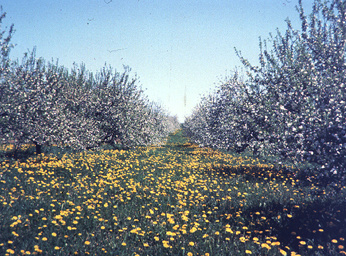
Pollination is the movement of male pollen to the female part of the flower (stigma), the first step in successful seed and fruit production by the plant. Self-pollination is when pollen is transferred from the anther to the stigma within a single plant. Cross-pollination is the transfer of pollen from one plant to the stigma of another plant. Once the plant has been pollinated, the male contribution fuses with the egg in the ovary, the process known as fertilization. After fertilization, the fruit and seeds develop and mature.
Although the male parts and female parts usually reside in a single flower, plants often have elaborate mechanisms to prevent self-fertilization. In some species the stigma of the flower ripens first, before the anthers are shedding pollen. Thus, it can be fertilized only by pollen brought from an older flower. In other plants, the opposite is true. The pollen is mature and shed before the stigma ripens. Other plants, such as squashes or watermelons, have sepa rate male and female flowers. A few plants, such as mulberry or olive, have separate male plants and female plants.
Some plants, for example grasses, produce light pollen grains that may be carried by the wind or water from plant to plant. Other plants need help from insects, birds, or bats for successful pollination. Without this assistance, fruit and/or seeds would not be formed. In fact, about a third of the food Americans eat is the direct result of pollination by in sects.
More than 100 agricultural crops in the United States are pollinated by bees. This means bees are important, if not essential, for the production of nearly $7 billion worth of agricultural crops produced annually in Arizona. Examples of bee pollinated crops include watermelons, cantaloupe, citrus and apples (see story below). Although some of these crops are pollinated by bee species other than honey bees, honey bees are the only ones that can be easily managed, moved around and are known to exploit a wide variety of crops.
While a worker bee is in a flower gathering nectar, pollen from the anther often sticks to her hairy body. Because the bee generally visits a number of the same type of flower in a patch, she will rub some of the pollen off onto the stigma of another flower and complete pollina tion. Some flowers such as orchids have elaborate mechanisms to make sure bees are dusted with pollen when they visit.
Part of the reason honey bees are so important as pollinators is that they actively seek out flowers with pollen, unlike pollinators such as bats and hummingbirds who are primarily interested in nectar. Pollen stored in the hive is used as a source of protein in feeding the developing larvae.
An apple for your teacher from the bees!
by Dr. Gloria Hoffman, USDA Scientist, Carl Hayden Bee Laboratory
When you go to the grocery store, there are lots of different apples that you can buy; Red or Golden Delicious, Granny Smith, McIntosh, just to name a few. Each variety of apple has a different shape and color, and a different flavor.
Did you ever wonder where apples come from or how an apple tree makes apples? Actually, apples start as flowers on the apple tree. Without the help of bees though, the flowers would bloom and then wither and drop without ever having a chance to become an apple. For a flower to become an apple, the pollen that is produced by the flowers on one apple tree must be transferred to the flowers on another tree. The pollen is moved between trees by bees who visit the flowers to collect nectar and pollen. Moving pollen between flowers is called cross-pollination.
One of the most important questions concerning cross-pollination of apple flowers is the way that bees move pollen between trees. When a honey bee finds an apple tree that has thou sands of flowers on it, the bee will stay on the same tree to collect nectar and pollen. If most bees stay on the same tree, how does pollen get moved between different trees so that cross-pollination occurs and apples can develop?
What was discovered is that honey bees can spread pollen to other bees in the hive. If you ever watched honey bees in a hive, you would see that they touch one another almost con stantly. If part of the honey bees in a hive are visiting Granny Smith apple trees and part are visiting Red Delicious trees, there is a good chance that both types of pollen will be on the bodies of most bees in the hive. Cross-pollination can occur when a honey bee that has Red Delicious pollen on its body that it obtained from other bees in the hive, is visiting Granny Smith flowers. The Red Delicious pollen will be deposited on to the first few Red Delicious flowers that the bee visits, and those flowers will have a good chance of becoming apples.
This is how plants and bees help one another. The plants make flowers that have nectar and pollen that the bees need for food. Pollen must be transferred between flowers for the plant to produce fruit and seeds so that new plants can be made. The pollen is transferred by bees while they collect the nectar and pollen. We also benefit from the relationship between bees and flowers because without it, we would not have apples or many other fruits and vegetables that we enjoy eating every day.
